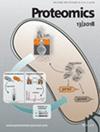Optimizing Proximity Proteomics on the EvoSep-timsTOF LC–MS System
Abstract
Proximity-dependent biotinylation (BioID) is a powerful means of exploring the cellular environments in which proteins reside. Expressing a protein of interest (bait) fused to a biotin ligase and adding biotin induces the covalent biotinylation of proximal partners (preys), which are recovered on streptavidin beads and identified by MS. However, a major technical limitation of BioID is peptide carryover into subsequent MS runs. This is typically mitigated via lengthy intersample wash cycles, which lowers throughput considerably. The aim of this study was to optimize BioID sample acquisition using an EvoSep LC system coupled to a timsTOF mass spectrometer, which has higher throughput and sensitivity than our current system, with less carryover. Our efforts resulted in an ∼15-fold increase in throughput using the 60 samples-per-day gradient with better sensitivity, and identifying nearly double the proteins found by our previously standardized workflow. Significance scoring also revealed more sensitive detection of high-confidence proximal interactions (∼1.5-fold) for five well-characterized baits, validating the new experimental workflow. Importantly, carryover was extremely limited, even without intersample washing, and limited to abundant proteins that are easily filtered during data analyses. Without washing, the newly optimized method can process 60 samples per day, using half of the sample amount previously required.
Summary
- Proximity-dependent biotinylation (PDB) coupled with MS is a powerful approach to characterize subcellular protein localization.
- However, the carry-over of peptides from the abundant proteins into subsequent MS runs is problematic. While this was previously mitigated by lengthy wash cycles of the chromatography column, this ultimately lowered throughput.
- The introduction of the EvoSep chromatography system and more sensitive MS instrumentation has enabled robust and fast analysis with lower sample amounts and minimal carry-over.
- To date, there has been no systematic evaluation of this EvoSep-timsTOF instrumentation for PDB, nor a direct comparison to a previously standardized workflow.
- This study compares the identifications between these acquisition setups, recommends sample loading and gradient settings for the EvoSep-timsTOF, and investigates the high-confidence proximal interactors identified.
- The results highlight the necessity of optimization of scoring approaches for PDB alongside faster MS methods to maximize recovery of known high-confidence proximal interactors.
- Importantly, the EvoSep-timsTOF system substantially increases the effective throughput of MS acquisition, as washing between samples could be eliminated without compromising the recovery of bona fide proximal interactors, likely due to both carry-over reduction from both the EvoSep chromatography system and the decreased sample load.




 求助内容:
求助内容: 应助结果提醒方式:
应助结果提醒方式:


